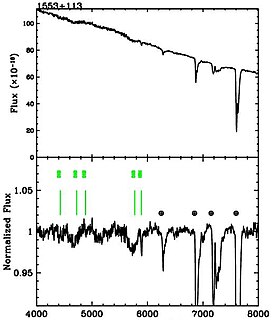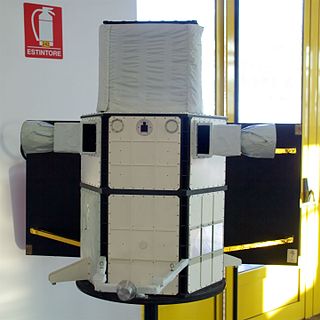
Piscis Austrinus is a constellation in the southern celestial hemisphere. The name is Latin for "the southern fish", in contrast with the larger constellation Pisces, which represents a pair of fishes. Before the 20th century, it was also known as Piscis Notius. Piscis Austrinus was one of the 48 constellations listed by the 2nd-century astronomer Ptolemy, and it remains one of the 88 modern constellations. The stars of the modern constellation Grus once formed the "tail" of Piscis Austrinus. In 1597, Petrus Plancius carved out a separate constellation and named it after the crane.
An active galactic nucleus (AGN) is a compact region at the center of a galaxy that has a much-higher-than-normal luminosity over at least some portion of the electromagnetic spectrum with characteristics indicating that the luminosity is not produced by stars. Such excess non-stellar emission has been observed in the radio, microwave, infrared, optical, ultra-violet, X-ray and gamma ray wavebands. A galaxy hosting an AGN is called an "active galaxy". The non-stellar radiation from an AGN is theorized to result from the accretion of matter by a supermassive black hole at the center of its host galaxy.

A blazar is an active galactic nucleus (AGN) with a relativistic jet directed very nearly towards an observer. Relativistic beaming of electromagnetic radiation from the jet makes blazars appear much brighter than they would be if the jet were pointed in a direction away from Earth. Blazars are powerful sources of emission across the electromagnetic spectrum and are observed to be sources of high-energy gamma ray photons. Blazars are highly variable sources, often undergoing rapid and dramatic fluctuations in brightness on short timescales. Some blazar jets exhibit apparent superluminal motion, another consequence of material in the jet traveling toward the observer at nearly the speed of light.

A BL Lacertae object or BL Lac object is a type of active galactic nucleus (AGN) or a galaxy with such an AGN, named after its prototype, BL Lacertae. In contrast to other types of active galactic nuclei, BL Lacs are characterized by rapid and large-amplitude flux variability and significant optical polarization. Because of these properties, the prototype of the class was originally thought to be a variable star. When compared to the more luminous active nuclei (quasars) with strong emission lines, BL Lac objects have spectra dominated by a relatively featureless non-thermal emission continuum over the entire electromagnetic range. This lack of spectral lines historically hindered identification of the nature and distance of such objects.

The Stanford Synchrotron Radiation Lightsource, a division of SLAC National Accelerator Laboratory, is operated by Stanford University for the Department of Energy. SSRL is a National User Facility which provides synchrotron radiation, a name given to electromagnetic radiation in the x-ray, ultraviolet, visible and infrared realms produced by electrons circulating in a storage ring at nearly the speed of light. The extremely bright light that is produced can be used to investigate various forms of matter ranging from objects of atomic and molecular size to man-made materials with unusual properties. The obtained information and knowledge is of great value to society, with impact in areas such as the environment, future technologies, health, biology, basic research, and education.

Upsilon Boötis is a single, orange-hued star in the northern constellation of Boötes. It is a fourth magnitude star that is visible to the naked eye. Based upon an annual parallax shift of 12.38 mas as seen from the Earth, it is located about 263 light years from the Sun. The star is moving closer to the Sun with a radial velocity of −6 km/s.

Q0906+6930 was the most distant known blazar at the time of its discovery in July, 2004. The engine of the blazar is a supermassive black hole (SMBH) approximately 2 billion times the mass of the Sun. The event horizon volume is on the order of 1,000 times that of the Solar System. It is one of the most massive black holes on record.

VERITAS is a major ground-based gamma-ray observatory with an array of four 12 meter optical reflectors for gamma-ray astronomy in the GeV – TeV photon energy range. VERITAS uses the Imaging Atmospheric Cherenkov Telescope technique to observe gamma rays that cause particle showers in Earth's atmosphere that are known as extensive air showers. The VERITAS array is located at the Fred Lawrence Whipple Observatory, in southern Arizona, United States. The VERITAS reflector design is similar to the earlier Whipple 10-meter gamma-ray telescope, located at the same site, but is larger in size and has a longer focal length for better control of optical aberrations. VERITAS consists of an array of imaging telescopes deployed to view atmospheric Cherenkov showers from multiple locations to give the highest sensitivity in the 100 GeV – 10 TeV band. This very high energy observatory, completed in 2007, effectively complements the Large Area Telescope (LAT) of the Fermi Gamma-ray Space Telescope due to its larger collection area as well as coverage in a higher energy band.
LS I +61 303 is a microquasar, a binary system containing a massive star and a compact object. The compact object is a black hole candidate and is around 7,000 light-years away.

NGC 4151 is an intermediate spiral Seyfert galaxy with weak inner ring structure located 15.8 megaparsecs from Earth in the constellation Canes Venatici. The galaxy was first mentioned by William Herschel on March 17, 1787; it was one of the six Seyfert galaxies described in the paper which defined the term. It is one of the nearest galaxies to Earth to contain an actively growing supermassive black hole. The black hole would have a mass on the order of 2.5 million to 30 million solar masses. It was speculated that the nucleus may host a binary black hole, with about 40 million and about 10 million solar masses respectively, orbiting with a 15.8-year period. This is, however, still a matter of active debate.

AGILE is an X-ray and gamma ray astronomical satellite of the Italian Space Agency (ASI).
The history of gamma-ray began with the serendipitous detection of a gamma-ray burst (GRB) on July 2, 1967, by the U.S. Vela satellites. After these satellites detected fifteen other GRBs, Ray Klebesadel of the Los Alamos National Laboratory published the first paper on the subject, Observations of Gamma-Ray Bursts of Cosmic Origin. As more and more research was done on these mysterious events, hundreds of models were developed in an attempt to explain their origins.
The Whole Earth Blazar Telescope (WEBT) is an international consortium of astronomers created in 1997, with the aim to study a particular category of Active Galactic Nuclei (AGN) called blazars, which are characterized by strong and fast brightness variability, on time scales down to hours or less.

3C 371 is a BL Lac object located in the constellation Draco. With a redshift of 0.051, this active galaxy is about 730 million light-years away.

Very-high-energy gamma ray (VHEGR) denotes gamma radiation with photon energies of 100 GeV (gigaelectronvolt) to 100 TeV (teraelectronvolt), i.e., 1011 to 1014 electronvolts. This is approximately equal to wavelengths between 10−17 and 10−20 meters, or frequencies of 2 × 1025 to 2 × 1028 Hz. Such energy levels have been detected from emissions from astronomical sources such as some binary star systems containing a compact object. For example, radiation emitted from Cygnus X-3 has been measured at ranges from GeV to exaelectronvolt-levels. Other astronomical sources include BL Lacertae, 3C 66A Markarian 421 and Markarian 501. Various other sources exist that are not associated with known bodies. For example, the H.E.S.S. catalog contained 64 sources in November 2011.

Markarian 501 is a galaxy with a spectrum extending to the highest energy gamma rays. It is a blazar or BL Lac object, which is an active galactic nucleus with a jet that is shooting towards the Earth.
Rosemary Hill Observatory (RHO) is an astronomical observatory located near the town of Bronson, Florida (USA), about 38 kilometers (24 mi) southwest of Gainesville, Florida. The observatory is owned and operated by the University of Florida, and opened in 1967. It has two telescopes and dormitories for extended observing runs.
TXS 0506+056 is a very high energy blazar – a quasar with a relativistic jet pointing directly towards Earth – of BL Lac-type. With a redshift of 0.3365 ± 0.0010, it is about 1.75 gigaparsecs from Earth. Its approximate location on the sky is off the left shoulder of the constellation Orion. Discovered as a radio source in 1983, the blazar has since been observed across the entire electromagnetic spectrum.
The Parkes Catalogue of Radio Sources, also known as the Parkes Southern Radio Source Catalog, consists of 8264 astronomical radio sources, mostly south of declination +27. The catalogue was mostly compiled by John Bolton and his colleagues for 20 years. Both the Molonglo 408-MHz survey and the 80-MHz Culgoora measurements of Slee et al have contributed to the usefulness of the catalogue. For now, the catalogue only contains sources originally found in the Parkes 2700-MHz survey. The catalogue contains radio sources that have a frequency range of 80 - 22,000 MHz.
AP Librae is a BL Lac object located at a distance of 700 million light years in the southern constellation of Libra. In the visual band it is one of the most active blazars known. AP Lib is surrounded by an extended source with a spectrum characteristic of a red-shifted giant elliptical galaxy. The derived visual magnitude of this region is 15.0, and it follows a radially decreasing brightness that is characteristic of an elliptical. Seven fainter galaxies are visible within an angular radius of 9′, suggesting it is the brightest member of a galactic cluster.












